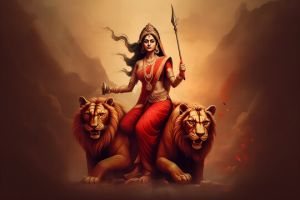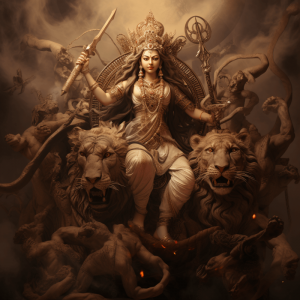Durga and Kali
by Kathryn LaFevers Evans, Three Eagles
Durga and Kali are Hindu Goddesses believed to be manifestations of the Great Goddess Devi and of Shakti, the female embodiment of the absolute and ultimate divine principle out of which all of creation is birthed and consumed.
Hindus embrace the circle of life—birth and death—as a cyclic divine process, and they understand that whatever is created out of the absolute must return to it. In the Hindu tradition, God and Goddess are inseparable, as two archetypal and interchangeable halves of the Androgyne (nonbinary gendered divinity). As female counterparts of Shiva the destroyer, Durga and Kali are often depicted as weapon-wielding and skull-
wielding Goddesses, respectively. Kali in particular is described and depicted as deep blue, a color associated with the transcendent absolute; she wears a necklace made of the skulls of her children, whom she has devoured. As Bhadrakali, worshipped by the gods, her form combines the two goddesses into one: Bhadrakali’s skin is deep blue and she wears a deep blue sari; wielding weapons in her many arms, she stands on the dead
body of her vanquished foe. During the Hindu age of devotion, or Upasana Kanda, the monotheistic Creator-God Brahman began to take on many personifications. “The metamorphosis from elitist Vedic ritualism to populist Hindu theism witnessed the rise of three theistic schools between
400 BCE and 300 CE” (Pattanaik 2003, 143). These schools worshipped Shiva, Vishnu, and Devi. In the latter theistic school, “Shaktism was the worship of the Goddess, or Devi, as Vishnu’s consort Lakshmi, Shiva’s consort Gauri, Brahma’s consort Saraswati, and her more independent forms,
Hinduism is a consciously syncretistic religious tradition, where male and female deities undergo transmutations under the vigilant and loving praise of their devotees. Kali personifies untamed nature, manifesting the duality of nature as life-giving Sexual Goddess and as life-taking Goddess of Death. The Devi Bhagavata Purana tells of the eight-armed bride-warrior Durga, who is formed when the fires of the devas or Gods fuse together. Riding a lion or tiger, Durga impales the Asuras, or demons, with her trident. In the Kalika Purana, Devi transforms into Kali, the Dark Goddess, naked and with hair unbound. Where Durga holds weapons and wears a red sari and bridal jewelry; Kali holds skulls, bones, severed limbs, and wears no clothes.
Kali is an expression of the universal Earth Goddess as archetypal Mouth of Hell. Her form is similar to that of Tlaltecuhtli in the Aztec tradition, who was depicted as a fierce Eagle Goddess inhabiting earth, considered to be the middle-world between heaven and hell. With a sacrificial
river of blood flowing from her tongue, she supports and guards the upper-world using her handtalons while crushing the dead in the underworld with her feet-talons. Like Tlaltecuhtli, Durga upholds and protects the order of heaven with her weapons, and Kali destroys the order of earth, thus creating the chaos of hell.
The Kailasa Shiva temple of carved stone in south-central India depicts Durga—along with the Goddesses Lakshmi and Parvati—another Shiva-consort manifestation. Goddesses in a demondestroying mode are portrayed with multiple arms. When Goddess Durga destroys the buffalodemon, she
frequently has 18 arms, each holding a different weapon. At the carved caves of Elephanta, India, Shiva and Parvati are shown merged in a single androgynous form, emphasizing the duality of life. The Shaiva cave called Mahishamardini, or Slayer of the Buffalo-Demon, has a square entrance
hole encompassed by a semi-circle of stylized, snarling animal heads (Dehejia 2006, 131-132, 140). This archetypal construct is also depicted in Christian iconography as the medieval European Hell’s Mouth, and by the Aztec as Tlaltecuhtli, all of which can be linked with the archetypal Earth Goddess who births and devours. We see this in nature as well, in Dragon’s Mouth at Yellowstone National Park for example. This is nature’s expression of this ancient archetype:
Dragon’s Mouth at Yellowstone National Park is a natural image of the archetypal Earth Goddess. The Hindu Goddesses Durga and Kali are seen as female embodiments of this Absolute Divine principle, out of which creation is birthed and consumed. (Kathryn LaFevers Evans)
A carved stone wall inside Mahishamardini depicts the battle, after which the cave is named, between the Goddess Durga and the buffalo-demon (Dehejia 2006, 197-199).
Native Gods and Goddesses of Tibet, the Ancient Protectors wear a necklace of skulls representing the protective mantras they invoke. In the Tibetan veneration of Tara they are worshipped by the Drukpa Kagyu—the Dragon Kaju lineage—named by its founder while on pilgrimage for the nine dragons seen roaring out of earth and into the sky. In the Mahabharata, two “Praises of Durga” coin new names for the Goddess Uma or Parvati.
She is called Durga, “The Terrible One,” a great protectress who delivers humans from dangers of the wilderness and other terrors. The veneration of Tara appropriates elements of Durga’s prowess, exemplified in these lines from a protective incantation: “Dark-blue light like sapphire . . . The dark-blue light
dissolves into me . . . and thus I will never be terrified or defeated” (Beyer 1978, 50-51, 229, 457).
Durga in her many manifestations is the subject of devotion during Durga Navratri, the annual 11-day October celebration, when the nine Shaktis of Durga are invoked. Young unmarried girls are also worshipped during Durga Puja. There is a saying among Hindus, that Kali claps her hands with glee when one of her children gets away. That escape from the cycle of birth, death, and rebirth signifies that Kali’s devotee has attained moksha or liberation. A few lines from Sathya Sai Baba’s oral tradition, in the form of a bhajan, or devotional chant to Mother Kali, summarize the intimate devotion of her devotees:
Some say Your aspect fills them with fear But to Your children, You are so dear My Blue Jewel, Kali Ma My Blue Jewel, Kali Ma
See also: Buddhism: Tara; Hinduism: Bhakti; Devi; Festivals; Lakshmi; Sacred Texts on Women; Shakti; Tantra
Further Reading
Beyer, Stephan. The Cult of Tara: Magic and Ritual in Tibet. Berkeley: University of California Press, 1978.
Dehejia, Vidya. Indian Art. New York: Phaidon Press Inc., 2006.
Pattanaik, Devdutt. Indian Mythology: Tales, Symbols, and Rituals from the Heart of the Subcontinent. Rochester VT: Inner Traditions, 2003.

